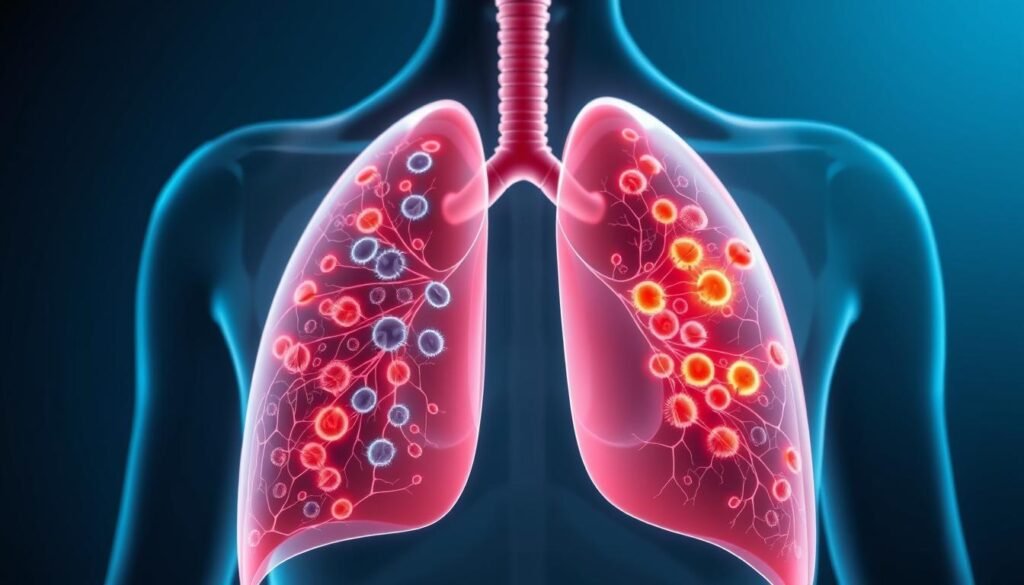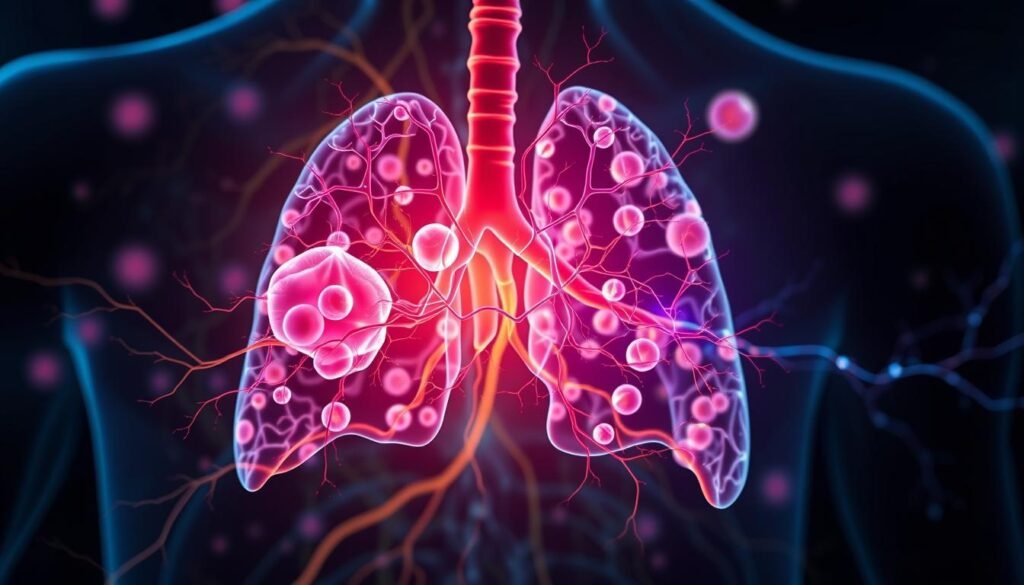The average five-year survival rate for all lung cancer stages and types is about 18.6%. This low number highlights how serious lung cancer is, especially when it spreads to the lymph nodes. Knowing about the life expectancy when lung cancer spreads to lymph nodes is key for patients and families. This article will explore survival rates, treatment options, and what influences outcomes in advanced lung cancer. It aims to provide helpful insights for those facing this tough diagnosis.
Key Takeaways
- The five-year relative survival rate for lung and bronchus cancer is 25.4%.
- Localized lung cancer has a significantly higher five-year survival rate of around 62.8%.
- Once lung cancer spreads to distant sites, the five-year survival rate drops to about 8%.
- Non-small cell lung cancer makes up 80-85% of all lung cancer cases.
- Age, overall health, and genetic factors play a big role in survival rates.
- Knowing the lung cancer stage helps decide the best treatment.
- Talking to healthcare providers is crucial for understanding what to expect and how to manage it.
Understanding Lung Cancer
Lung cancer mainly attacks the lungs, causing rapid cell growth in lung tissues. It’s a leading cause of death from cancer around the world. It’s responsible for about 25% of all cancer deaths, say the experts at the American Lung Association.
There are two key kinds of lung cancer: non-small cell lung cancer (NSCLC) and small cell lung cancer (SCLC). NSCLC is more common, making up 80% to 85% of cases. SCLC accounts for 10% to 15%. These types have big differences in outcomes and treatment methods.
Knowing about what is lung cancer means understanding its stages and progression. Around 53% of lung cancers have spread at diagnosis. The stage is key in determining how well a patient might do; survival rates change greatly with the cancer’s stage. For localized NSCLC, the 5-year survival is about 65%. But, stage 4 survival falls to 9%. For stage 4 SCLC, the survival rate is just 3%.
Looking at the lung cancer general information, younger people tend to do better than older ones. Factors like gender, race, genetic changes, and lifestyle choices impact survival. Quitting smoking helps. Certain genetic changes can mean better results with targeted treatment.
For more on survival rates by stage and other factors, check the American Cancer Society. They show how catching the cancer early and the right treatment matter.
| Cancer Type | Localized Survival Rate | Regional Survival Rate | Distant Survival Rate | All Stages Survival Rate |
|---|---|---|---|---|
| NSCLC | 65% | 37% | 9% | 23% |
| SCLC | 30% | 18% | 3% | 6% |
Types of Lung Cancer
Lung cancer is split into two main types: non-small cell and small cell lung cancer. Each type is different in how it’s treated and its outlook.
Non-Small Cell Lung Cancer (NSCLC) is the most common, with 80-85% of cases falling under this category. It includes:
- Adenocarcinoma
- Squamous cell carcinoma
- Large cell carcinoma
NSCLC might be removed through surgery if it hasn’t spread much. Other options are drug therapy aimed at mutations and immunotherapy. These treatments help the immune system fight the cancer.
Small Cell Lung Cancer (SCLC) makes up about 10-15% of lung cancer cases. It grows quickly and often spreads early on. Treatment usually combines chemotherapy and radiation.
Understanding both types is important. This helps doctors choose the right treatment and predict outcomes better.
Stages of Lung Cancer
Doctors use the TNM classification system to stage lung cancer. This system looks at tumor size (T), if the cancer has reached lymph nodes (N), and if it has spread elsewhere (M). Knowing the stage of lung cancer helps decide on treatment options and what to expect.
The stages for non-small cell lung cancer (NSCLC) go from early to advanced. They are described as:
- Stage 0: The cancer is not visible yet.
- Stage I: The cancer is only in the lungs.
- Stage II: The cancer has reached nearby lymph nodes.
- Stage III: There’s more extensive lymph node involvement.
- Stage IV: The cancer has spread to far-off organs. This is the most severe stage.
Small cell lung cancer (SCLC) is categorized differently. It is divided into:
- Limited Stage: The cancer is in one part of the chest only.
- Extensive Stage: The cancer has spread from where it started.
Getting lung cancer staged accurately is key for effective treatment. It also helps patients and their families deal with the emotional impact of a diagnosis.
How Lung Cancer Spreads to Lymph Nodes
Lung cancer spreads in various ways, with the lymphatic system playing a big role. This system acts as both a filter and a pathway for cancer cells to reach lymph nodes. Lung cancer lymph node involvement means cancer cells are in the lymph nodes. This affects a patient’s treatment and prognosis.
Knowing how lung cancer spreads is vital. It tells us how and where the cancer might move next. Once in the lymph nodes, the cancer can spread more widely, leading to advanced lung cancer. The cancer’s stage and the lymph nodes’ condition help decide treatment and chances of survival.
An overview of how lung cancer affects lymph nodes can be summarized in the following table:
| Stage of Lung Cancer | Characteristics | Survival Rate |
|---|---|---|
| Localized | No lymph node involvement | 65% for NSCLC, 30% for SCLC |
| Regional | Involvement of nearby lymph nodes | 37% for NSCLC, 18% for SCLC |
| Distant | Spread to distant organs or regions | 9% for NSCLC, 3% for SCLC |
Stage 3 lung cancer is a turning point for treatment choices. For instance, patients with stage 3A NSCLC might undergo surgery. But in stages 3B and 3C, the cancer has spread more, often making surgery not an option. Knowing about lung cancer lymph node involvement helps doctors plan the best treatment.

Lung Cancer Spread to Lymph Nodes Life Expectancy
Lung cancer spreading to lymph nodes impacts life expectancy. Knowing survival rates of metastatic lung cancer is crucial. It helps in making treatment choices and supports emotional health.
Survival Rates for Metastatic Lung Cancer
The survival rate changes based on lung cancer’s stage when found. For stage 4 non-small-cell lung cancer (NSCLC), the 5-year survival rate is about 6%. Small-cell lung cancer is worse, with a 5-year survival rate of 3%. These numbers show why detecting and treating lung cancer early is vital.
Factors Affecting Survival Rates
Many things affect survival chances for people with metastatic lung cancer. Factors include age, overall health, and the lung cancer type. Younger, healthier patients often do better. The success of treatment also matters a lot.
Differences in health care across groups can change survival rates too. Sometimes, lifestyle changes like stopping smoking help people live longer.
Impact of Lymph Node Involvement on Prognosis
Lymph nodes play a big role in lung cancer’s outlook. Lymph node involvement prognosis gets worse as more nodes are affected. This issue changes how doctors handle the disease and its survival chances. A study showed that people with stage IIIA/N2 lung cancer had a 47.4% chance of living five more years.
This situation shows why catching cancer early is crucial. Starting treatment sooner can lead to better results.
Age, certain cancer stages, and added chemotherapy matter a lot for nsclc prognosis. If cancer spreads to a lot of lymph nodes, the risk of it moving further goes up. People with cancer in their lymph nodes have different survival chances. It depends on how the cancer spreads.
Adding chemotherapy can make a big difference. It lifts the five-year survival rate to 62.3%, much better than other options. Patients with upper lung cancer and lymph node spread lived longer. They had a 53.9% five-year survival rate, unlike those without it, who had a 27.3% rate.
Seeing the warning signs early and knowing about lymph node involvement’s impact is key. It leads to getting help fast and perhaps better odds of beating lung cancer. Catching lung cancer early is essential for improving the prognosis. For more details on symptoms and early signs, visit this resource.

Life Expectancy for Non-Small Cell Lung Cancer
Non-small cell lung cancer (NSCLC) is the most common type of lung cancer. It makes up about 80–85% of cases. The NSCLC life expectancy depends a lot on how early it’s found. For all NSCLC stages combined, the five-year survival rate is around 28%.
If NSCLC is found early, the survival rate jumps to about 65%. This is good news for those caught early. But as the cancer grows, survival rates fall. When it spreads to nearby areas, the rate is about 37%. And if it reaches far-off parts of the body, it drops to 9%.
Many treatments exist for NSCLC, like surgery, chemotherapy, and new, targeted therapies. Clinical trials are always testing new ways to improve survival. For stage 3 NSCLC, certain chemotherapies before or after surgery help a lot. Also, medicines targeting specific genetic changes can raise NSCLC life expectancy for some patients.
| Stage | Five-Year Survival Rate |
|---|---|
| Localized NSCLC | 65% |
| Regional NSCLC | 37% |
| Distant NSCLC | 9% |
Knowing about lung cancer statistics helps patients and families make smart choices. Advances in treatment can greatly improve NSCLC life expectancy, especially with early detection and specialized care.
Life Expectancy for Small Cell Lung Cancer
Small cell lung cancer (SCLC) poses significant challenges regarding life expectancy and overall prognosis. SCLC statistics show that this aggressive cancer mainly affects those who smoke. An estimated 234,580 new lung cancer cases will be diagnosed in the United States in 2024. SCLC will make up about 13 percent of these cases.
The chance of survival with small cell lung cancer depends greatly on how early it is found. For cases found early, the five-year survival rate is 30%. For those found at a regional stage, it drops to 18%. And, for the advanced-stage SCLC, the survival rate is only 3%. On average, the five-year survival rate for all stages combined is about 7%. These numbers highlight the struggles patients and their families go through.
Life expectancy for small cell lung cancer changes a lot between the early and late stages. People with early-stage SCLC have a median survival of around 20 months. Those with late-stage SCLC usually live between 8 to 12 months. How old someone is when they are diagnosed also affects how long they might live, as the following table shows:
| Age Group | Median Survival (Months) | 1-Year Survival Rate (%) | 3-Year Survival Rate (%) |
|---|---|---|---|
| 18–49 years | 12 | 49.9 | 15.7 |
| 50–69 years | 10.8 | 44.9 | 14.3 |
| 70 years and older | 8.5 | 34.9 | 9.7 |
| All ages | 10.1 | 41.8 | 12.8 |
This data shows that younger patients usually have better survival chances than older ones. Detecting the cancer early and using treatments like chemotherapy and immunotherapy are key. They can help improve small cell lung cancer life expectancy despite its usually poor prognosis. There’s still hope for better outcomes in the future, thanks to ongoing research and new treatments.
Treatment Options for Metastatic Lung Cancer
There are multiple ways to treat metastatic lung cancer. These include both traditional methods and new strategies. They aim to manage symptoms and extend life.
For patients and caregivers, knowing these treatments is key. It helps them navigate this complicated condition.
Immunotherapy Drugs
Immunotherapy has become a key player in treating lung cancer. Drugs like Opdivo (nivolumab) and Keytruda (pembrolizumab) boost the immune system’s fight against cancer. They offer hope and better results for those with advanced cancer.
Targeted Therapies
Targeted therapies, including Tecentriq (atezolizumab) and Imfinzi (durvalumab), focus on the cancer’s genetic aspects. They provide a personalized treatment, leading to potentially better outcomes and fewer side effects. Choosing between immunotherapy and targeted treatments depends on the cancer type and patient health.
Exploring life expectancy with stage 4 lung cancer can offer valuable insights. It’s crucial for making informed decisions. Regular talks with healthcare providers are essential.
| Treatment Type | Examples | Impact on Survival |
|---|---|---|
| Immunotherapy | Opdivo, Keytruda | Boosts immune response against cancer |
| Targeted Therapy | Tecentriq, Imfinzi | Personalized treatment targeting genetic mutations |
| Chemotherapy | Carboplatin, Pemetrexed | Standard treatment that may reduce tumor size |
| Radiation Therapy | Prophylactic cranial radiotherapy | Helps prevent spread to the brain |
Lifestyle Factors Affecting Life Expectancy
Lifestyle choices are crucial for lung cancer patients’ life expectancy. It’s important to understand how these choices affect their health and survival.
Importance of Quitting Smoking
Quitting smoking is vital for those diagnosed with lung cancer. Stopping smoking can significantly boost their survival chances. It connects ongoing tobacco use with less effective treatments.
Quitting smoking may extend life by months. It’s a very important choice for lung cancer patients.
Overall Health and Comorbidities
Overall health and other illnesses play a big role in lung cancer treatment and survival. Those who are healthier before finding out they have lung cancer respond better to treatment. This can lead to a better chance of survival.
Other health problems like heart disease or diabetes can make treating lung cancer harder. Staying active, eating right, and going to the doctor can help deal with these issues. It’s key for patients and their families to know how big a role overall health plays in fighting lung cancer.

Making positive changes in your lifestyle can help deal with symptoms and boost your well-being. For more details on how age and health impact outcomes, check out this comprehensive study.
Conclusion
It’s very important to understand lung cancer and how it spreads. This knowledge is key for both patients and caregivers. The article sheds light on what impacts the life expectancy of someone with lung cancer. Even though survival rates tend to be low, new treatments and healthy lifestyle changes can really help.
Men and those with a high ECOG performance status face tougher challenges. But research and personalized treatments are changing outcomes for the better. Knowing these details helps patients and doctors work together on the best care plans.
Boosting cancer awareness helps people get the care and support they need sooner. Being updated on treatments and lifestyle improvements is crucial. Together, we can offer hope and improve lives, despite tough diagnoses.